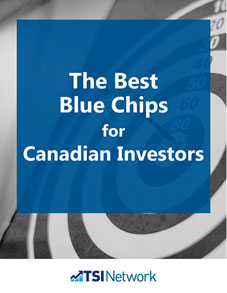Topic: Blue Chip Stocks
These consumer stocks offer value & growth
A key element of our investment advice is to spread your money across most if not all the five economic sectors: Finance; Utilities; Consumer Goods & Services; Resources & Commodities; and Manufacturing & Industry. That way, you avoid overloading yourself with stocks that are about to slump simply because of industry conditions or changes in investor fashion.
Generally speaking, stocks in the Resources & Commodities sector and the Manufacturing & Industry sector expose you to above-average volatility. Those in the Finance and Utilities sectors involve below-average volatility, while Consumer stocks are in the middle.
To further cut risk, stick with Consumer stocks that have strong brands and sound balance sheets such as the four we analyze below. However, not all four are currently buys.
LOBLAW COMPANIES LTD. $71 (Toronto symbol L; Conservative Growth Portfolio, Consumer sector; Shares outstanding: 400.9 million; Market cap: $28.5 billion; Price-to-sales ratio: 0.6; Dividend yield: 1.5%; TSI Network Rating: Above Average; www.loblaw.ca) operates Canada’s largest supermarket chain. Its 1,098 stores include a variety of banners: Loblaw, Zehrs, Provigo, Real Canadian Superstore and No Frills. In March 2014, the company purchased the Shoppers Drug Mart chain for $12.3 billion in cash and shares. Shoppers operates 1,326 drug stores across Canada.
Loblaw’s overall sales in the three months ended December 31, 2016, rose 2.4%, to $11.1 billion from $10.9 billion a year earlier. Strong customer traffic during the holiday season helped offset lower food prices.
Excluding gasoline purchases, same store sales at Loblaw’s supermarkets rose 1.1%. Same-store sales for Shoppers Drug Mart gained 3.4%. That reflects a 2.5% rise in prescription drug sales and a 4.1% increase in the sale of other merchandise.
Eliminating overlapping operations between Shoppers Drug Mart and the supermarkets has cut Loblaw’s annual costs by $300 million. That’s largely why its earnings in the fourth quarter rose 8.3%, to $393 million from $363 million a year earlier. Earnings per share gained 11.5%, to $0.97 from $0.87, on fewer shares outstanding.
In 2017, Loblaw plans to spend $1.3 billion on store upgrades and improvements to its computer inventory systems. The company can comfortably afford those investments. Its long-term debt of $10.5 billion (as of December 31, 2016) is a manageable 37% of its market cap. Loblaw also held cash of $1.6 billion, or $3.88 a share.
The company’s solid balance sheet also puts it in a strong position to make acquisitions. For example, it recently paid $167 million for QHR Corp. Based in Kelowna, B.C., that firm makes software to manage electronic medical records for doctors and other medical professionals. QHR’s expertise will help Shoppers Drug Mart convert its client records from paper to an electronic format.
In July 2016, Loblaw raised its quarterly dividend by 4.0%, to $0.26 a share from $0.25. The new annual rate of $1.04 yields 1.5%. The company will also use its improved earnings to buy back stock. In 2016, it spent $708 million on share repurchases.
The company will probably earn $4.43 a share for all of 2017. The stock trades at 16.0 times that forecast.
Loblaw is a buy.
METRO INC. $41 (Toronto symbol MRU; Aggressive Growth Portfolio, Consumer sector; Shares outstanding: 228.1 million; Market cap: $9.4 billion; Price-to-sales ratio: 0.7; Dividend yield: 1.6%; TSINetwork Rating: Average; www.metro.ca) operates 600 grocery stores and 250 drugstores, in Quebec and Ontario.
The stock has declined 15% since it hit $48 in July 2016. That’s mainly because falling food prices and strong competition have slowed its sales and earnings growth.
In response, Metro will convert some of its conventional stores to its discount chain, Food Basics. It’s has also begun to renovate existing outlets.
Metro aims to spur future growth with premium products. Some of those will come from its 75% stake in privately held bakery Première Moisson, which has 25 stores and two plants. The company also owns 55% of Adonis Group, which sells Mediterranean-style foods through 11 stores.
Those businesses continue to pay off for Metro. For its 2017 first quarter, ended December 17, 2016, same-store sales rose 0.7%, even though average food prices fell 1.0%. The company also continues to benefit from its 5.7% stake in Alimentation Couche-Tard (Toronto symbol ATD.B). That company operates convenience stores in North America and Europe. (Couche-Tard is a recommendation of Stock Pickers Digest, our newsletter that focuses on aggressive investing.) Based on current prices, that holding is worth roughly $2.0 billion, or 21% of Metro’s market cap.
The company’s balance sheet is sound. As of December 17, 2016, its long-term debt was just $1.4 billion, or 15% of Metro’s market cap. It also held cash of $6.6 million. Metro’s earnings will likely rise 8.4% in fiscal 2017, to $2.59 a share. The stock trades at 15.8 times that forecast. The company also recently increased its quarterly dividend by 16.1%. The new annual rate of $0.65 yields 1.6%.
Metro is a buy.
CANADIAN TIRE CORP. (Toronto symbols CTC $204 and CTC.A $163; Conservative Growth Portfolio, Con sumer sector; Shares outstanding: 70.2 million; Market cap: $11.6 billion; Price-to-sales ratio: 0.9; Dividend yield: 1.8%; TSINetwork Rating: Above Average; www.canadiantire.ca) owns 500 Canadian Tire stores. They sell automotive, household and sporting goods. Franchisees run most of the outlets. The company’s other operations include 296 gas stations and 91 PartSource locations; those stores focus on automobile supplies.
In the past few years, the company has acquired other major retail chains: Mark’s sells casual and work clothing through 382 stores; and the Forzani Group sells sporting goods and athletic wear through 433 stores, including Sport Chek and Sports Experts.
In the three months ended December 31, 2016, Canadian Tire’s overall sales rose 7.7%, to $3.6 billion from $3.4 billion. Overall same-store sales improved 7.9%.
Same-store sales at the company’s Canadian Tire stores jumped 8.1%. That was mainly due to strong demand for both seasonal and non-seasonal goods. Same-store sales at the Forzani stores improved 5.1% on strong demand for winter-related shoes and sporting goods. Higher sales of winter goods also pushed up same-store sales at the Mark’s chain by 10.6%. An increase in gasoline prices and volumes caused sales at Canadian Tire’s gas stations to gain 5.9%.
Thanks to the higher revenue, overall earnings in the quarter rose 9.6%, to $246.8 million from $225.2 million. Per-share earnings gained 15.1%, to $3.46 from $3.01, on fewer shares outstanding.
The company ended the quarter with cash of $936.4 million, or $13.24 a share. Its long-term debt of $4.2 billion is a manageable 36% of its market cap.
Canadian Tire plans to spend between $425 million and $475 million on its retail operations in 2017. The midpoint—$450 million—is slightly below the company’s 2016 spending of $455.8 million. Most of this year’s outlays will go toward the expansion of its online operations, including building new distribution centres.
The class A non-voting shares have gained 23% in the past year. Even so, they still trade at an attractive 16.2 times the $10.09 a share that Canadian Tire will likely earn in 2017. The $2.60 dividend yields 1.6%. The class A shares are more liquid than the closely held voting shares.
Canadian Tire class A stock is a buy.
MAPLE LEAF FOODS INC. $32 (Toronto symbol MFI; Conservative Growth Portfolio, Consumer sector; Shares outstanding: 132.1 million; Market cap: $4.2 billion; p/s ratio: 1.3; Divd. yield: 1.4%; TSINetwork Rating: Average; www.mapleleaffoods.com) sells Maple Leaf and Schneider fresh and prepared meats.
The company has now finished a restructuring plan to significantly reduce its operating costs by shifting meat production to newer, more-efficient plants. Thanks to the savings, Maple Leaf earned $0.31 a share in the fourth quarter of 2016. That’s up 24.0% from $0.24 a year earlier.
Maple Leaf’s sales in the quarter fell 5.1%, to $828.2 million from $873.1 million. The year-earlier quarter benefitted from an extra week. On a comparable basis, sales improved 2.0%.
In the latest quarter, Maple Leaf’ gross profit margin (gross profits as a percentage of revenue) improved to 10.4%. That beat the target of 10.0%.
The company now aims to spur its growth with new products. For example, it recently agreed to pay $140 million U.S. for Lightlife Foods, Inc.
This private firm, based in Massachusetts, makes refrigerated plant-based protein foods. Those products include hamburgers and hot dogs that look and taste like regular meat products. Lightlife will add $40 million U.S. to Maple Leaf’s annual sales and contribute to its 2017 earnings.
The company is in a strong position to make more acquisitions. As of December 31, 2016, it held cash of $403.6 million, or $3.06 a share; long-term debt was just $9.1 million.
Maple Leaf has jumped 18% in the past year, and now trades at a high 22.7 times the company’s projected 2017 earnings of $1.41 a share. The $0.44 dividend yields 1.4%.
Maple Leaf Foods is still a hold.



